ISS: SpaceX Demo-1 (International Space Station: SpaceX Commercial Resupply Service Demo-1 Mission/Crew Dragon Demo-1, Officially Crew Demo-1, SpaceX Demo-1, or Demonstration Mission-1)
Non-EO
NASA
Mission complete
Human Spaceflight
Quick facts
Overview
| Mission type | Non-EO |
| Agency | NASA |
| Mission status | Mission complete |
| Launch date | 02 Mar 2019 |
| End of life date | 08 Mar 2019 |
ISS: SpaceX Demo-1 (International Space Station: SpaceX Commercial Resupply Service Demo-1 Mission/Crew Dragon Demo-1, Officially Crew Demo-1, SpaceX Demo-1, or Demonstration Mission-1)
First Uncrewed Test Flight of the Commercial Crew Program
SpX-DM1 is an uncrewed flight test to the International Space Station as part of NASA's Commercial Crew Program. The launch of SpaceX's Falcon 9 rocket and Crew Dragon spacecraft is targeted for Jan. 17, 2019, from historic Launch Complex 39A at NASA's Kennedy Space Center in Florida. 1)
This will be the first uncrewed test flight of the Commercial Crew Program and will provide data on the performance of the Falcon-9 rocket, Crew Dragon spacecraft, and ground systems, as well as on-orbit, docking and landing operations. The flight test also will provide valuable data toward NASA certifying SpaceX's crew transportation system for carrying astronauts to and from the space station.
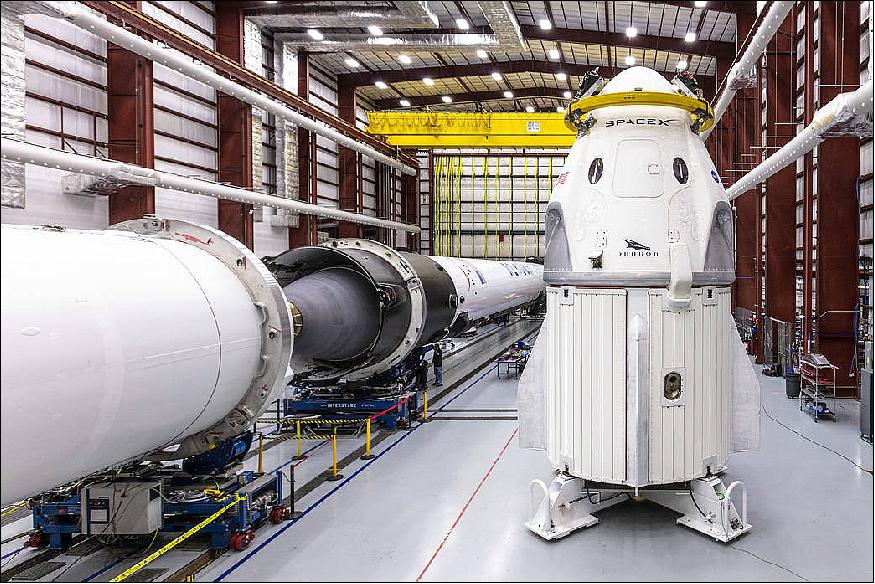
The spacecraft will test the approach and automated docking procedures with the International Space Station (ISS), remain docked for a few weeks, then conduct the full re-entry, splashdown and recovery steps to provide data requisite to subsequently qualify for flights transporting humans to the ISS. Life support systems will be monitored all along the test flight. The same capsule will be re-used later for an in-flight abort test.
Launch
The Crew Dragon SpX-DM1 inaugural mission of SpaceX to the ISS was launched on 2 March 2019 (07:49 UTC) from LC-39A (Launch Complex-39A) at Cape Canaveral, FL. 3)

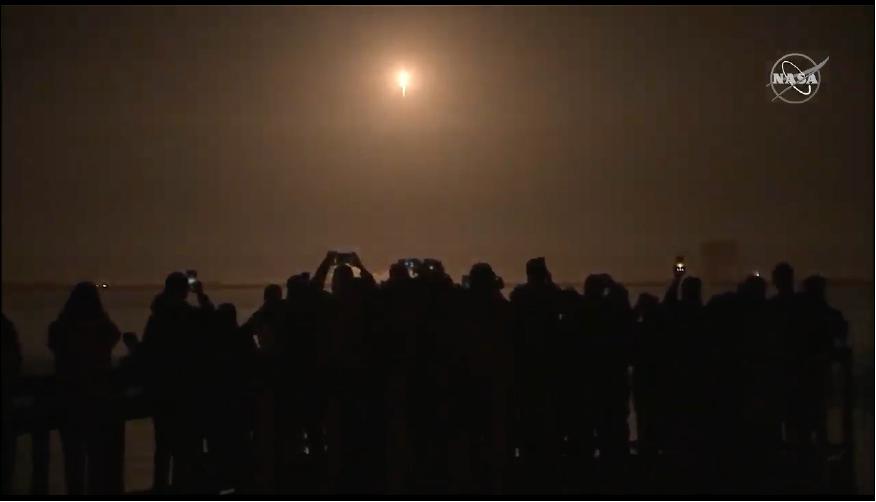
For the first time in history, a commercially-built and operated American crew spacecraft and rocket, which launched from American soil, is on its way to the International Space Station. The SpaceX Crew Dragon spacecraft lifted off at 2:49 a.m. EST (07:49 UTC) Saturday on the company's Falcon 9 rocket from Launch Complex 39A at NASA's Kennedy Space Center in Florida.
"Today's successful launch marks a new chapter in American excellence, getting us closer to once again flying American astronauts on American rockets from American soil," said NASA Administrator Jim Bridenstine. "I proudly congratulate the SpaceX and NASA teams for this major milestone in our nation's space history. This first launch of a space system designed for humans, and built and operated by a commercial company through a public-private partnership, is a revolutionary step on our path to get humans to the Moon, Mars and beyond."
Known as Demo-1, SpaceX's inaugural flight with NASA's Commercial Crew Program is an important uncrewed mission designed to test the end-to-end capabilities of the new system. It brings the nation one-step closer to the return of human launches to the space station from the United States for the first time since 2011 – the last space shuttle mission. Teams still have work to do after this flight to prepare the spacecraft to fly astronauts. The best way to advance the system design was to fly this spacecraft and uncover any other areas or integrated flight changes that might be required.
The program demonstrates NASA's commitment to investing in commercial companies through public-private partnerships and builds on the success of American companies, including SpaceX, already delivering cargo to the space station. Demo-1 is a critical step for NASA and SpaceX to demonstrate the ability to safely fly missions with NASA astronauts to the orbital laboratory.
"First a note of appreciation to the SpaceX team. It has been 17 years to get to this point, 2002 to now, and an incredible amount of hard work and sacrifice from a lot of people that got us to this point... I'd also like to express great appreciation for NASA," said Elon Musk, CEO and lead designer at SpaceX. "SpaceX would not be here without NASA, without the incredible work that was done before SpaceX even started and without the support after SpaceX did start."
The public-private partnership combines commercial companies' unique, innovative approaches to human spaceflight and NASA's decades-long experience in design, development and operations of a crew space system.
"We are watching history being made with the launch of the SpaceX Demo-1 mission," said Steve Stich, launch manager and deputy manager of NASA's Commercial Crew Program. "SpaceX and NASA teams have been working together for years, and now we are side-by-side in control rooms across the country for launch, in-orbit operations and, eventually, splashdown of the Crew Dragon right here off Florida's coast."
SpaceX controlled the launch of the Falcon 9 rocket from Kennedy's Launch Control Center Firing Room 4, the former space shuttle control room, which SpaceX has leased as its primary launch control center. As Crew Dragon ascended into space, SpaceX commanded the Crew Dragon spacecraft from its mission control center in Hawthorne, California. NASA teams will monitor space station operations throughout the flight from Mission Control Center at the agency's Johnson Space Center in Houston.
The SpaceX Crew Dragon spacecraft is on its way to the space station for a 6:05 a.m. Sunday, March 3 docking to the low-Earth orbit destination. Live coverage of the rendezvous and docking will air on NASA Television and the agency's website beginning at 3:30 a.m. Coverage will resume at 8:30 a.m. with the hatch opening, followed at 10:45 a.m. with a crew welcoming ceremony.
Teams in the space station mission center at Johnson will monitor station crew members' opening of the spacecraft hatch, entering Crew Dragon and unpacking the capsule.
Mission Objectives
All the launch pad and vehicle hardware, and the launch day operations, were conducted in preparation for the next flight with crew aboard, including the control teams and ground crews. The mission and testing continues once the Falcon-9 lifts off the pad.
During the spacecraft's approach, in-orbit demonstrations will include rendezvous activities from a distance of up to 4 km, known as far field, and activities within one mile (1.6 km), known as near field. As the spacecraft approaches the space station, it will demonstrate its automated control and maneuvering capabilities by reversing course and backing away from the station before the final docking sequence.
The docking phase, as well as the return and recovery of Crew Dragon, include many first-time events that cannot be totally modeled on the ground and, thus, are critical to understanding the design and systems ability to support crew flights. Previous cargo Dragon vehicles have been attached to the space station after capture by the station's robotic arm. The Crew Dragon will approach to dock using new sensor systems, new propulsion systems and the new international docking mechanism to attach to the station's Harmony module forward port, fitted with a new international docking adapter. Astronauts installed the adapter during a spacewalk in August 2016, following its delivery to the station in the trunk of a SpaceX Dragon spacecraft on its ninth commercial resupply services mission.
For Demo-1, Crew Dragon is carrying more than 400 pounds (181 kg) of crew supplies and equipment to the space station and will return some critical research samples to Earth. A lifelike test device named Ripley also will travel on the Crew Dragon, outfitted with sensors to provide data on potential effects on humans traveling in Crew Dragon.
For operational missions, Crew Dragon will be able to launch as many as four crew members and carry more than 220 pounds (100 kg) of cargo, enabling the expansion of the crew members, increasing the time dedicated to research in the unique microgravity environment, and returning more science back to Earth.
The Crew Dragon is designed to stay docked to station for up to 210 days, although the Crew Dragon used for this flight test will not have that capability. This spacecraft will remain docked to the space station only five days, departing Friday, March 8. After undocking from the station, Crew Dragon will begin its descent to Earth. Live coverage of the undocking will air on NASA Television and the agency's website beginning at 2 a.m., with deorbit and landing coverage resuming at 7:30 a.m.
Additional spacecraft mission objectives include a safe departure from the station, followed by a deorbit burn and parachute deployment to slow the spacecraft before splashdown in the Atlantic Ocean, off the Florida Space Coast. SpaceX's recovery ship, Go Searcher, will retrieve Crew Dragon and transport it back to port. Teams will be closely monitoring the parachute system and entry control system operation, which have been changed from cargo Dragons to provide higher reliability for crew flights.
NASA and SpaceX will use data from Demo-1, along with planned upgrades and additional qualification testing, to further prepare for Demo-2, the crewed flight test that will carry NASA astronauts Bob Behnken and Doug Hurley to the International Space Station. NASA will validate the performance of SpaceX's systems before putting crew on board for the Demo-2 flight, currently targeted for July.
NASA's Commercial Crew Program is working with Boeing and SpaceX to design, build, test and operate safe, reliable and cost-effective human transportation systems to low-Earth orbit. Both companies are focused on test missions, including abort system demonstrations and crew flight tests, ahead of regularly flying crew missions to the space station. Both companies' crewed flights will be the first times in history NASA has sent astronauts to space on systems owned, built, tested and operated by private companies.
Crew Dragon at the ISS
• March 4, 2019: The National Space Society has congratulated SpaceX and NASA on successfully docking the Dragon 2 spacecraft to the International Space Station (ISS) at 5:51 AM EST Sunday, March 3rd. 4)
- This historic event is part of the DM-1 uncrewed mission to test all aspects of a commercially sourced and built-in-the-USA system for bringing astronauts to and from the International Space Station. Dragon 2 demonstrated "docking," an onboard automatic process previously used by the space shuttle, as opposed to "berthing," a simpler approach relying on a robot arm attached to the ISS to grab the capsule. Successful demonstration of this process is a significant step forward for SpaceX. The International Docking Adaptor-1 that was previously lofted to the ISS by SpaceX on the CRS-9 mission was used in the docking. The Dragon 2 contains "Ripley," an instrumented mannequin, and 181 kg. of supplies for the ISS. The Dragon 2 is targeted to return to Earth on 8 March. A successful return will pave the way for a crewed mission later in the year.
• March 3, 2019: After making 18 orbits of Earth since its launch early Saturday morning, the Crew Dragon spacecraft successfully attached to the International Space Station's Harmony module forward port via "soft capture" at 5:51 a.m. EST (10:51 GMT on Sunday, 3 March 2019) while the station was traveling more than 400 km over the Pacific Ocean, just north of New Zealand — and 27 hours after the capsule's launch on a SpaceX Falcon 9 rocket from the Kennedy Space Center at Cape Canaveral in Florida. 5)
As the spacecraft approached the space station, it demonstrated its automated control and maneuvering capabilities by arriving in place at about 150 m away from the orbital laboratory then reversing course and backing away from the station to 180 m before the final docking sequence from about 20 m away.
The Crew Dragon used the station's new IDA (International Docking Adapter) for the first time since astronauts installed it during a spacewalk in August 2016, following its delivery to the station in the trunk of a SpaceX Dragon spacecraft on its ninth commercial resupply services mission.
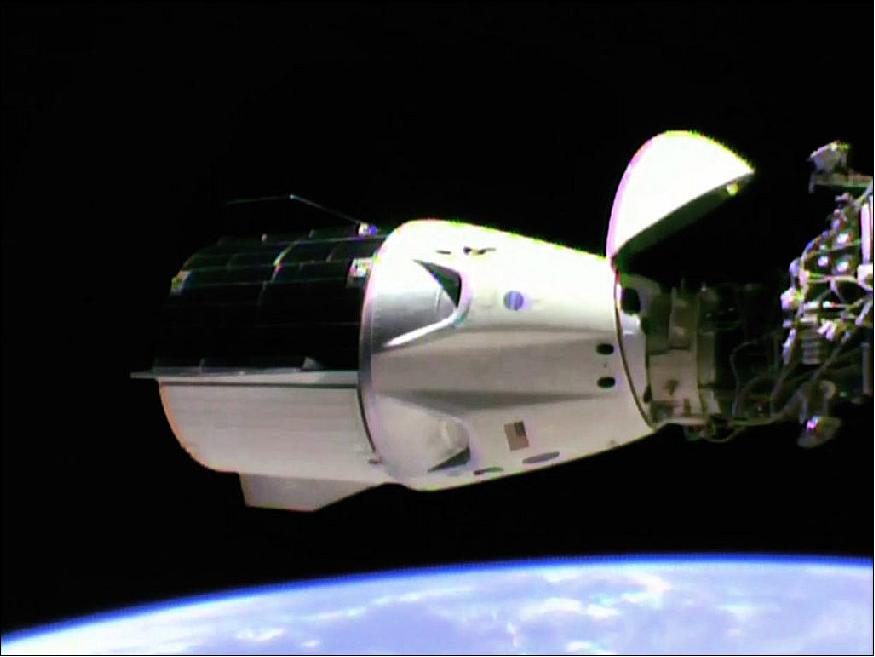
Aboard the space station, NASA astronaut Anne McClain, David Saint-Jacques of the Canadian Space Agency, and Russian cosmonaut and Expedition 58 commander Oleg Kononenko opened the hatch between the Crew Dragon and the orbital laboratory at 13:07 GMT. 6)
The crew members opened the hatch to Crew Dragon following standard leak checks and pressurization since the spacecraft completed its hard dock to the station at 10:02 GMT, the first autonomous docking of any U.S. spacecraft to the International Space Station.
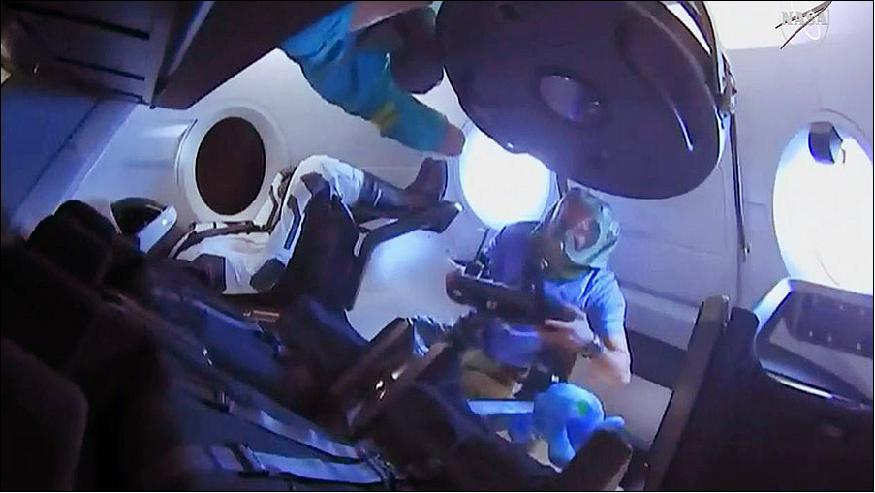
In addition to carrying Ripley, an ATD (Anthropomorphic Test Device) outfitted with sensors to provide data about potential effects on future astronauts who will travel in the Crew Dragon. NASA also sent more than 400 pounds (181 kg) of crew supplies and equipment to the space station, including bulk overwrap bags containing more than 1,000 food and drink packages for the crew.
For operational missions, Crew Dragon will be able to launch as many as four crew members and carry more than 100 kg of cargo, enabling the expansion of the inhabitants of the space station, increasing the time dedicated to research in the unique microgravity environment, and returning more science back to Earth.
Dragon is a free-flying spacecraft designed to deliver both cargo and people to orbiting destinations. It is the only spacecraft currently flying that is capable of returning significant amounts of cargo to Earth. Currently Dragon carries cargo to space, but it was designed from the beginning to carry humans. The first demonstration flight under NASA's Commercial Crew Program was launched on March 2, 2019 at 2:49 a.m. ET or 7:49 UTC. 7)
Return Flight of Crew Dragon
• March 8, 2019: At 2:32 a.m. EST (7:32 GMT) on Friday ,8 March, the Crew Dragon undocked from the Harmony module of the International Space Station to begin the final phase of its uncrewed Demo-1 flight test. The spacecraft is slowly maneuvering away from the orbital laboratory into an orbital track that will return it and its cargo safely to Earth. 8) 9)
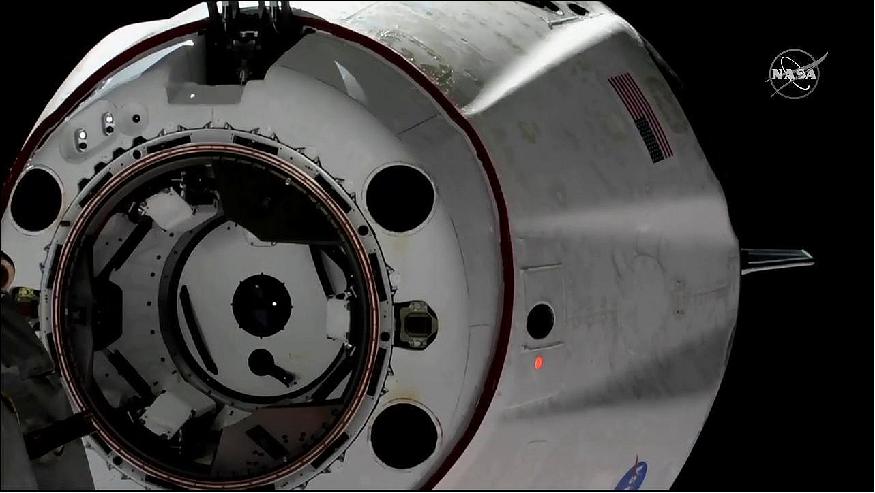
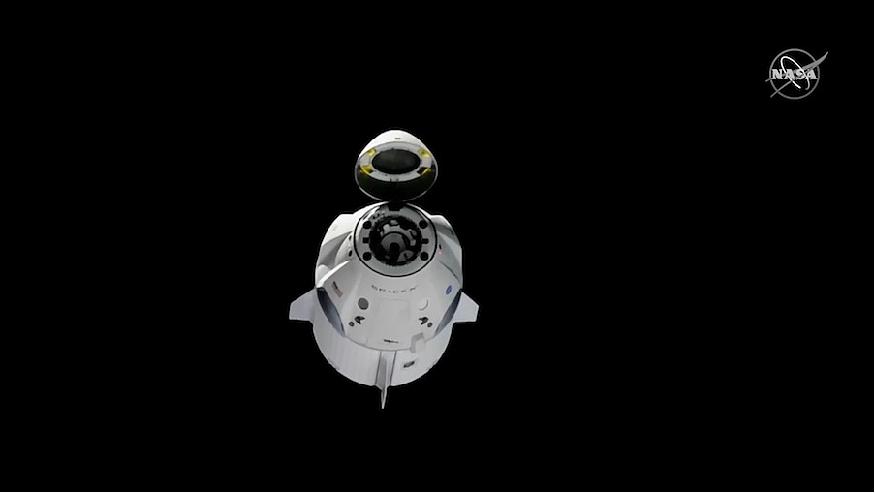
The capsule jettisoned its rear trunk at 7:48 a.m. EST (12:48 GMT), leaving the power module behind in orbit as the crew return craft ignited its Draco thrusters again at 7:52 a.m. EST (12:52 GMT) for a 15-minute, 25-second braking burn. The impulse from the deorbit burn slowed the capsule's velocity enough to drop its orbit into the atmosphere, allowing friction from air particles to bring the Crew Dragon back to Earth. 10)
After closing a protective nose cone over its docking port and hatch, the capsule encountered the first traces of the atmosphere at 8:33 a.m. EST (13:33 GMT) as it flew on a northwest-to-southeast track over the United States, and temperatures outside the Crew Dragon built up to thousands of degrees.
A NASA WB-57 research airplane flying over the Atlantic captured live infrared video of the Crew Dragon spacecraft emerging from the re-entry plasma sheath, then showed the spaceship deploying a pair of drogue stabilization parachutes, followed by the unfurling of four orange and white main chutes.
The parachute deployment was closely watched by SpaceX and NASA engineers. The older cargo-carrying Dragon spacecraft comes down under three chutes, while the heavier Crew Dragon requires four, and parachute anomalies during testing — and on the return of a Dragon supply ship — have put the system under greater scrutiny from engineers and safety managers.
About 6 hours after departing the space station, Crew Dragon splashed down at 8:45 a.m. EST (13:45 GMT) approximately 230 miles off the coast of Cape Canaveral, Florida. SpaceX retrieved the spacecraft from the Atlantic Ocean and is transporting it back to port on the company's recovery ship. 11)

- "Today's successful reentry and recovery of the Crew Dragon capsule after its first mission to the International Space Station marked another important milestone in the future of human spaceflight," said NASA Administrator Jim Bridenstine. "I want to once again congratulate the NASA and SpaceX teams on an incredible week. Our Commercial Crew Program is one step closer to launching American astronauts on American rockets from American soil. I am proud of the great work that has been done to get us to this point."
- NASA and SpaceX teams gathered in the early morning hours at the company's headquarters in Hawthorne, California, to follow the spacecraft's return journey and ocean splashdown.
- "We were all very excited to see re-entry, parachute and drogue deploy, main deploy, splashdown – everything happened just perfectly. It was right on time, the way that we expected it to be. It was beautiful," said Benji Reed, director of crew mission management at SpaceX.
- A critical step in validating the performance of SpaceX's systems, Demo-1 brings the nation a significant step closer to the return of human launches to the space station from U.S soil for the first time since 2011, when NASA flew its last space shuttle mission. However, NASA and SpaceX still have work to do to validate the spacecraft's performance and prepare it to fly astronauts.
- "If you just think about the enormity of this flight and all of the prep that went into it – getting the pad refurbished, getting the flight control room set up, getting the vehicle built, getting the Falcon 9 ready, all of the analysis and mission support that went into it – it's just been a tremendous job. Our NASA and SpaceX teams worked seamlessly not only in the lead-up to the flight but in how we managed the flight," said Steve Stich, deputy manager of NASA's Commercial Crew Program.
- Crew Dragon carried a passenger on this flight test – a lifelike test device named Ripley, which was outfitted with sensors to provide data about potential effects on humans traveling in the spacecraft. After SpaceX processes data from this mission, teams will begin refurbishing Crew Dragon for its next mission, an in-flight abort test targeted to take place this summer. Demo-2, the first crewed test flight, will carry NASA astronauts Bob Behnken and Doug Hurley on the spacecraft's final flight to certify Crew Dragon for routine operational missions.
- "For the first time, we've gotten to see an end-to-end test, and so now we've brought together the people, the hardware and all the processes and procedures, and we've gotten to see how they all work together, and that's very important as we move toward putting people onboard," said NASA astronaut Mike Hopkins, who will crew SpaceX's first operational mission to the space station following Demo-2. "I'm, personally, very anxious to hear how Ripley is feeling after they pull her out of the capsule and get her onto the recovery vehicle."
References
1) "NASA Invites Media to SpaceX Demo-1 Launch," NASA, 21 November 2018, URL: https://www.nasa.gov/press-release/nasa-
invites-media-to-spacex-demo-1-launch
2) "SpaceX's Crew Dragon Spacecraft and Falcon 9 Rocket," NASA, 19 December 2018, URL: https://www.nasa.gov/image-feature/spacex-s-
crew-dragon-spacecraft-and-falcon-9-rocket
3) Josh Finch / Stephanie Schierholz, "NASA, SpaceX Launch First Flight Test of Space System Designed for Crew," NASA News Release 19-014, 2 March 2019, URL: https://www.nasa.gov/press-release/nasa-spacex-
launch-first-flight-test-of-space-system-designed-for-crew
4) National Space Society Applauds the Successful Dragon 2 Docking with the ISS," Satnews Daily, 4 March 2019, URL: http://www.satnews.com/story.php?number=1642672806
5) Mark Garcia,"SpaceX Crew Dragon Successfully Docks to Station," NASA, 3 March 2019, URL: https://blogs.nasa.gov/spacestation/2019/03/03/
spacex-crew-dragon-successfully-docks-to-station/
6) Mark Garcia, "SpaceX Crew Dragon Hatch Open," NASA, 3 March 2019, URL: https://web.archive.org/web/20190304111704/https://blogs.nasa.gov/spacestation/2019/03/03/spacex-crew-dragon-hatch-open/
7) "First Private Spacecraft to the Space Station," SpaceX, 4 March 2019, URL: https://web.archive.org/web/20190302165756/https://www.spacex.com/dragon
8) Norah Moran, "Crew Dragon Undocks from the International Space Station," NASA, 8 March 2019, URL: https://web.archive.org/web/20190417170542/https://blogs.nasa.gov/spacestation/2019/03/08/crew-dragon-undocks-from-the-international-space-station/
9) https://blogs.nasa.gov/spacestation/
10) Stephen Clark, "SpaceX crew capsule returns to Earth, paving the way for human launches," Spaceflight Now, 8 March 2019, URL: https://spaceflightnow.com/2019/03/08/spacex-crew-capsule-
returns-to-earth-paving-the-way-for-human-launches/
11) "SpaceX Crew Dragon Splashdown Marks Success of First NASA Commercial Crew Flight Test," NASA, 8 March 2019, Release 19-016, URL: https://www.nasa.gov/press-release/spacex-crew-
dragon-splashdown-marks-success-of-first-
nasa-commercial-crew-flight-test
The information compiled and edited in this article was provided by Herbert J. Kramer from his documentation of: "Observation of the Earth and Its Environment: Survey of Missions and Sensors" (Springer Verlag) as well as many other sources after the publication of the 4th edition in 2002. - Comments and corrections to this article are always welcome for further updates (eoportal@symbios.space).